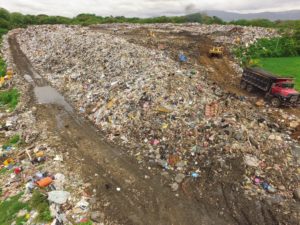What Happens to America’s Waste?
 America has the third-largest population in the world, behind China and India. Each individual in the U.S. produces a large quantity of trash. After items reach their expiration, they end up in landfills or recycling facilities.
America has the third-largest population in the world, behind China and India. Each individual in the U.S. produces a large quantity of trash. After items reach their expiration, they end up in landfills or recycling facilities.
Residents often place their trash bins on the curb each week without thinking about it. Few people know where their garbage and recycling end up.
The First Step
When waste management professionals pick up your trash, they bring it directly to a transfer station. The station holds garbage temporarily. People also sort through waste and remove inappropriate materials.
Workers then move materials to their designated processing locations. Some waste management groups also deliver trash to material recovery facilities (MRFs), where professionals sort through debris and collect recyclable materials.
There are two different types of MRFs. Clean MRFs receive recyclable items, which residents and businesses previously sorted. Dirty MRFs accumulate a combination of reusable products and landfill waste.
After professionals separate recyclable materials from trash, they transport the components to landfills, recycling centers, composts, incinerators and anaerobic digestors.
1. Landfills
American landfills accumulate over 146.1 million tons of garbage annually and hold most municipal solid waste (MSW) in the U.S. Before landfills, debris would build up in the streets and cause hygiene problems.
Society’s health and well-being improved when waste management professionals developed designated garbage centers. Environmentalists established landfill alternatives after assessing the facilities’ adverse ecological impacts. One significant effect of landfills comes from stormwater runoff.
When it rains, stormwater carries toxins from landfills to the ocean. Some MSW contains nitrogen and phosphorus, which cause algal blooms. Blue-green algae contain toxins like microcystin that harm people’s health. Marine creatures and mammals that consume this algae may experience liver failure and nervous system damage.
2. Recycling Centers
People who sign up for curbside recycling support local sustainability efforts. Residents and businesses recycle about 35% of their MSW annually. This waste is broken down and repurposed at recycling facilities.
America recycles about 66% of its paper and cardboard. It also repurposes about 27% of all glass products. People only recycle nearly 8% of their plastic goods, which harms the environment.
Residents, company owners and waste management professionals must improve national recycling systems. Current limitations cause marine microplastic accumulation. Manufacturing plastic also creates greenhouse gas emissions, which cause climate change.
Recycling plastic minimizes aquatic biodiversity loss. It also protects the atmosphere from emission-related degradation. Composting waste also improves global environmental sustainability.
3. Composts
People can compost biological waste and give nutrients back to the environment through composting, which minimizes soil erosion. Nutrient-rich soil efficiently holds moisture and decreases stormwater runoff.
This sustainable waste management method also conserves landfill space. Residents and business owners can create on-site composts or sign up for curbside services.
4. Incinerators
Waste professionals developed incinerators to save landfill space. Garbage that reaches an incinerator is heated to generate electricity.
The waste-to-energy (WTE) method increases incineration’s sustainability. The process that creates power still produces emissions and toxic pollution, interfering with ecological conservation, but it’s a step in the right direction.
5. Anaerobic Digesters
Anaerobic digesters decompose manure and other organic products. The digester technology uses microbes to break down used materials into biogas.
Some facilities use biogas as a fossil fuel alternative. Waste management professionals store the excess solid material to minimize surface-level pollution.
Which Waste Management Technique Is Best for You?
Most residents invest in curbside garbage and recycling pickup. These two waste management techniques can effectively process an individual’s trash. People and business owners may utilize additional waste processing techniques to prevent surface-level and atmospheric pollution. Investing in multiple practices may improve environmental conservation.
Author Bio:
Jane works as the founder and editor-in-chief of Environment.co where she covers environmental news and sustainable living tips.


